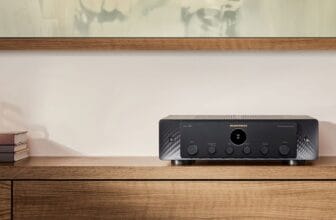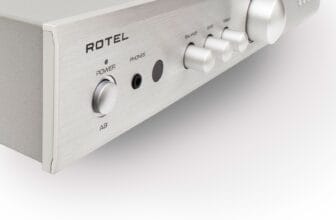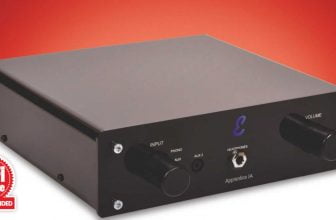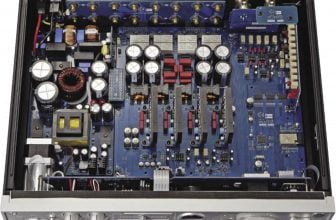Moonriver audio model 404 review
Noel Keywood takes a shine to Moonriver Audio’s Model 404 amplifier. Read our Moonriver audio model 404 review.
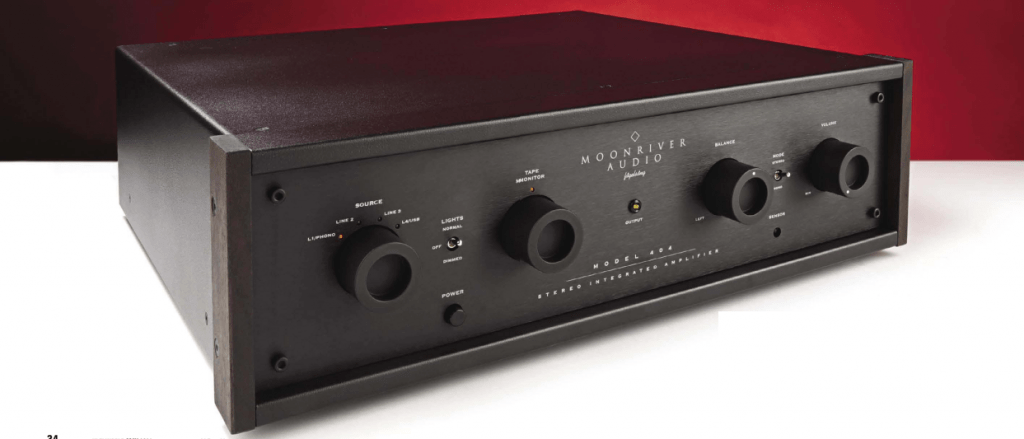
Inspired by the song apparently, Moonriver Audio design and manufacturer specialist amplifiers in Sweden. Their website is big on superlatives but a little short of detail – just like the handbook – about the Model 404 I am reviewing here, so I had to get digging as it were… and there was a lot to find. For what is claimed to be a 50 Watt amplifier the Model 404 is priced (phew!) in the version we received with MM/MC phono board, but no digital. An optional USB input will become available in future but our sample lacked this feature.
If that sounds like a big price tag for a basic analogue amplifier it is because George Polychronidis of Moonriver claims “every component of Moonriver 404 was chosen after extensive listening tests, since everything is critical for the sound.
Another study was accomplished in order to achieve sustainability, reliability and repairability. Unlike many other amplifiers, Moonriver is made to last for many decades due to my experience in repairing and it is very easy to service. For this reason we used only through hole components because there are more options and they are more reliable. There is no standby function as well for reliability reasons”. There is however a small plastic-case remote control to select input and control volume, but switch-on is manual by front panel push button.
The Model 404 is a big amplifier, especially in view of its power output and sparse facilities. The case measures 430mm wide, 135mm high and 390mm deep but weighs no less than 12kgs. A large contribution comes from the folded steel cover that alone weighs a few kg, being made of thicker-than-usual steel I found when removing it. The chassis is sturdy too, the Reference version being even sturdier and with padded casework apparently (plus upgraded power supply).
This is a basic analogue amplifier with, George says, “integrated, class AB power modules that are extremely flexible and sensitive to the external components and power supplies. They are extremely stable, electronically and thermally, they have very short signal path, the transistor halves are laser trimmed and they include all the protections like thermal shutdown, servo DC offset, over voltage protection, short circuit protection etc. They offer a level of safety that you can’t get with discrete designs”. I speculate they’re Sanken (Japan) power modules designed for hi-fi use and a popular if rarely mentioned choice for amplifier output stages. George alludes to the important aspect of thermal tracking (management) that Sanken modules are known for, difficult to control unless you are the device manufacturer.
Volume control is by Alps Blue motorised potentiometer, another popular choice – one we used in the 1990s with World Audio Design amplifiers.You either use a motor or a switched resistor network, the latter being preferable, if more complex.
Another obligatory component back then were Panasonic sealed, low level relays with low contact resistance and inert gas to ensure over one million operations. I was heartened to see quality sealed relays (Omron) in this amplifier.
Moonriver use discrete transistors too I was surprised to find.You normally go down this route for better tonality and indeed that is what Moonriver claim for the Model 404. However, there are integrated circuits, in the phono stage for example, where they are a common choice nowadays.
But all of this is not on display. What a potential user sees is a heavy, sturdy case with satin black
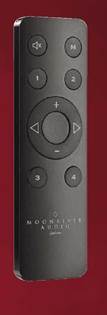
“Her voice had silky presence and organic naturalness. There was no added zing here; the romance was unsullied, even slightly honeyed”
finish and small wooden cheeks to hide end-detail between fascia and case. There’s a rotary input selector at left that chooses between four Line inputs in the standard model, but Line 1 is allocated to Phono if the optional board is fitted and Line 4 is allocated to USB as and when this stage becomes available. A small toggle switch can dim or switch off the few orange LEDs, although I do not know why you would want to do this. Another toggle switch selects Mono operation which can be useful for LP, and there’s a Balance control as well, again useful for LP. The standard of finish is good, but not exceptional.
For anyone still in possession of a three-head cassette deck or open-reel recorder there is a tape monitor function too, but this is a blast from the past I’m unsure many will ever use, let alone want – even me with a Nakamichi ZX-9 staring down from a shelf high above (oh nostalgia). Missing are balanced XLR inputs: this is a phono socket only amplifier.
Our review sample came with an MM/MC phono board. The handbook makes clear that it can be user-adjusted to select MM (moving magnet) or MC (moving coil), but this is the only selection available; there are no loading or gain options. To do this eight hex screws securing the amplifier’s cover must be removed, then three Philips cross-head screws securing a screen over the board, because it is close to a power supply rectifier and the circuits have extremely high gain – something that’s always difficult to cope with; screening obligatory.
So switching between MM and MC is not easy, unlike many phono stages where it’s achieved by the
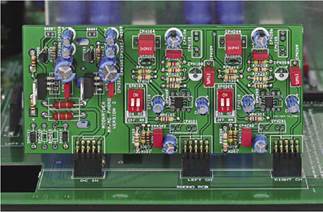
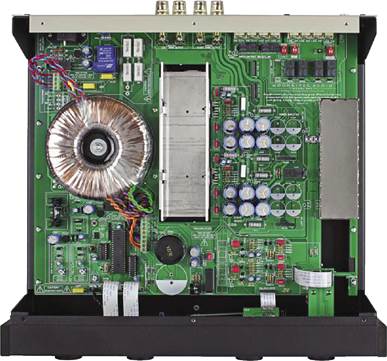
push of a button. MC loading is 100 Ohms and MM loading 47k Ohms, both standard values. With vast gain the 404 can accept the lowest output MCs, the volume control being set low. It is relatively quiet, if not the quietest possible; high-end phono stages can manage 6dB less noise.
And finally, measurement showed whilst the RIAA equalisation of MC was accurate, MM was different and less accurate, with a tad less low frequency gain below 1kHz (3 18muyS characteristic), so I used both cartridge types in listening tests to assess this issue.
SOUND QUALITY
The Moonriver 404 was connected to our Martin Logan ESL-X hybrid electrostatic loudspeakers via Chord Company Signature Reference cables. It was fed digital from our Oppo UDP-205D with its ESS ES9038 Pro convertor, through Chord Company Epic interconnects. The Phono stage was assessed using a Timestep Evo modified Technics SL-1210 Direct Drive turntable with SME309 arm fitted alternatively with an Audio Technica OC9X MC cartridge and VM750 SH MM cartridge.
Spinning a wide range of Rock from CD it became clear the 404 delivers an easy going sound with fulsome presence. First message to flash up was “this is lovely and relaxing”. It didn’t get anything wrong: the jangling distorted guitars in Skunk Anansie’s Hedonism just jangled – they didn’t sound harsh.
I was made aware of the track’s strong, supple bass guitar line and Skin sounded distinctly human! With capacious sound staging that brought in a nice sense of depth – not valve amp standard but still good – this awkward track showed the 404 to be an amplifier with class.
However, immediate need to orientate. After long listening the 404 was consistently svelte and relaxed – and if you like the valve sound as I do then you’ll be drawn into its sonic charms. Those that want a fast, visceral, punchy delivery may want to look elsewhere – to Musical Fidelity or Chord Electronics for example. The 404 is a deeply engaging listen, putting power into the sound, but it doesn’t jump out and bite. Josefine Cronholm crooned in warmly enveloping space, singing In Your Wild Garden, the ambience of her surroundings captured by the microphone slickly conveyed.
Plucked bass line strode along behind with a sense of confident power: strong but not aggressive.
Such a presentation suits Classical and sure enough that’s what I found with Tchaikovsky’s Capriccio Italiano where strings burst out strongly from a deep space, surrounded by the recording venue’s acoustic. Well defined images of the orchestral sections and a strong sense of depth made this a convincing experience. There was plenty of low-end thunder to convey a sense of power to proceedings.
A similarly smooth rendition of Renee Fleming singing O mio babbino caro drifted out, her voice having silky presence and organic naturalness. There was no added zing here; the romance was unsullied, even slightly honeyed.
Moving onto the Phono stage I started off with our Audio Technica OC9X SH (Shibata) moving coil cartridge because MC equalisation was accurate, allowing me to hear the stage in correct form. And, if anything, the 404 became more 404-ish, organically smooth and big bodied with the opening drum line of Sing, Sing, Sing from the Syd

Lawrence Orchestra (Big Band Spectacular) pounding out with fluid force. The brass section had rich rasp but my ears weren’t assaulted: it was all big and fruity. And so it went on through a wide selection of LPs, a very analogue sound in fact. Forget hard edges and laceration. Think beguiling.
With MM there was indeed a small degree of extra midrange presence that pushed vocals forward slightly, making Stevie Nicks pleasantly clear singing Dreams from Rumours for example, but surprisingly as I played through a wide variety of LPs the 404 retained its smooth, easy nature, deep sound staging and excellent stereo imaging.
CONCLUSION
The Moonriver Audio Model 404 is a well honed specialist amplifier with gorgeous analogue sound. Powerful, supple bass is a big plus point, bringing a sense of body to all that passes through it. This included the Phono stage in MC form in particular, but even MM with its lighter patina due to differing equalisation was a joy to hear.
No doubt the Model 404 has superb sound but whether it will appeal has to be a value decision since the price tag is a big one for an amplifier short on facilities.
MEASURED PERFORMANCE
The Moonriver Audio Model 404 amplifier produced 40 Watts into 8 Ohms and 64 Watts into 4 Ohms. The company quote 50 Watts into 8 Ohms, or 40 Watts of “clean power”, which is what we measure (i.e. before clipping). Around 50 Watts will be produced into a nominally 6 Ohm loudspeaker, which most are, so justifiably a 50 Watt amplifier.
Frequency response ran from 12 Hz to 20kHz at half volume our analysis shows. At low volume this extended to 80kHz, but at full volume the upper limit was just 13kHz (-1dB). Frequency extension was volume dependent. With high sensitivity of 95mV for full output, low volume will likely be used in practice, giving a satisfactory result, but frequency response should not change with volume control position.
Distortion was low at 0.01% in the midband at 1 Watt to 0.02% at full output. At 10kHz results were similar, so no crossover distortion. This is a very linear amplifier at low and high power outputs, at all frequencies and into 4 Ohms too.
Input sensitivity was very high at 95mV for full output, meaning high gain in the line stages – and this fed through to the phono stage.
RIAA equalisation was accurate with the board switched to MC, a warp filter acting below 40Hz. Sensitivity again very high, just 0.1mV in for full output, so the lowest output moving coil cartridges can be used. However, with equivalent input noise (e.i.n.) measuring 0.19muyV this is not a super quiet stage; slight hiss will be audible close to the ‘speakers.
RIAA equalisation for MM differed from MC slightly but lay between +/1dB limits from 40Hz to 20kHz. Again, sensitivity was very high at 0.8mV for full output, overload high and noise reasonably low at 0.2muyV in (e.i.n.).
The amplifier measured well enough, if with some inconsistencies in MM/MC phono RIAA EQ and alteration of response with volume. NK

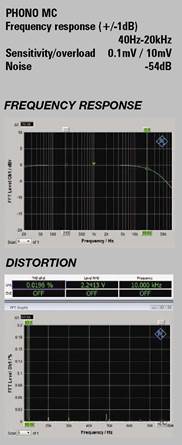
MOONRIVER AUDIO MODEL 404
EXCELLENT – extremely capable.
VERDICT
Whole Note Distribution +44 (0)203 911 5549 www.wholenotedistribution.co.uk


